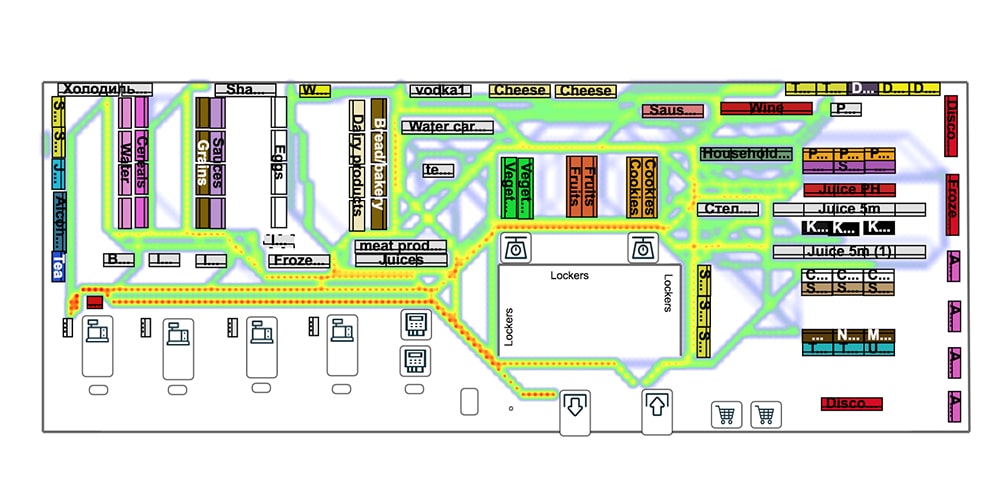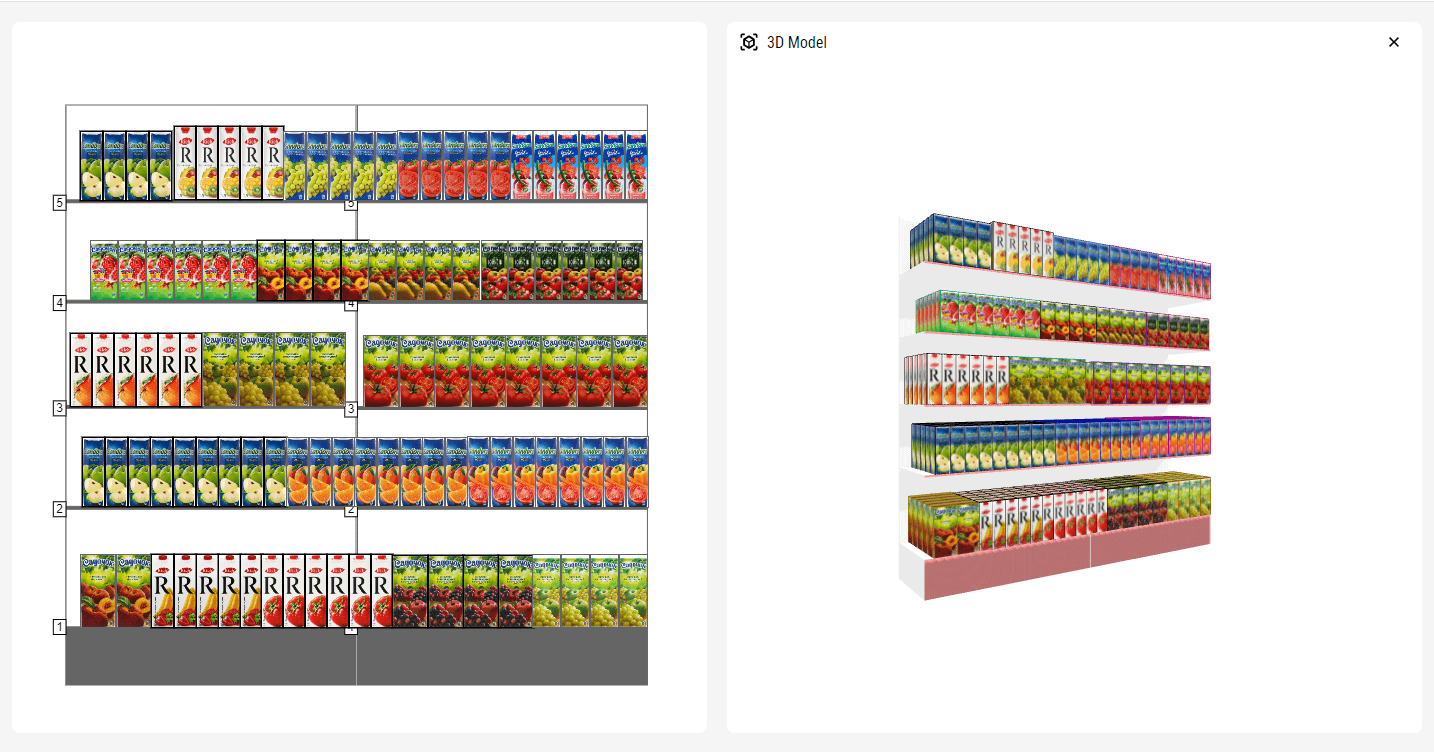Table of Contents:
What is meant by Planogramming?
Practical Strategies in Retail 2024
The use of shelf planogram tools is changing the retail landscape by transforming how merchandise is displayed to maximize sales and improve the customer experience. A well-designed planogram not only determines the strategic product layout on shelves and displays but also helps to effectively plan store space, increase sales, and control inventory. Thanks to visual merchandising planograms, retailers can significantly increase sales efficiency by maximizing every inch of shelf space.
What is a Planogram?
A planogram is a virtual shelf layout that shows how and where certain SKUs should be placed on shelves or displays to increase the number of purchases.
What is meant by Planogramming?
Learning the ins and outs of planogramming is crucial for optimizing retail space and driving sales. Here are some critical strategies for arranging products on the planogram and subsequently on the shelves:
Visual Merchandising
It uses the principles of human visual perception and increases customer engagement through attractive shelf design.
By visually appealing shelf designs, retailers can grab customers' attention and encourage them to explore the products on the shelves. This technique involves carefully arranging products, using color schemes and effective signage to help customers navigate the store and highlight critical products or promotions.
The main goal of visual merchandising is to create an aesthetically pleasing and coherent environment that attracts customers and encourages them to make purchases.
When creating a visual merchandising planogram, you should consider human visual perception. Products placed on the shelves at eye level (the golden shelf) are more likely to attract attention, while the lower shelves are for oversized products or those more geared toward children.
By placing products at eye level and using attractive packaging and creative displays, retailers can effectively communicate the value and benefits of their products to potential customers.
For the visual improvement of the store, the location of the shelving used plays an important role. Thus, you can control customer behavior with the help of retail equipment and their location on the store plan. Planogram tools allow you to create a store plan, place the right equipment on it, and analyze the movement of visitors with the help of heat maps.

Heat map of customer traffic in PlanoHero service
Combining shelving, the correct arrangement of rows and aisles, adherence to the golden triangle principle, and an attractive shelf layout will encourage customers to buy more goods.
In addition to shelf design, visual merchandising encompasses elements such as lighting, music, and the overall floor plan. Using appropriate lighting can increase the visual appeal of products. Similarly, carefully selected music can influence the mood and perception of customers, further enhancing their overall experience.
Overall, visual merchandising is an influential tool retailers can use to create an immersive and memorable shopping experience. By understanding and utilizing visual patterns, retailers can effectively engage customers, build brand awareness, and drive sales.
Cross Merchandising
Cross-merchandising is a strategy that involves placing complementary products from different categories together on retail equipment to drive additional purchases. This technique is widely used in retail to maximize sales. For example, placing batteries next to electronic devices or displaying chips and sauces together can encourage customers to purchase both products.
 An example of cross-merchandising in a store - source
An example of cross-merchandising in a store - source
Cross-merchandising not only increases sales but also helps to create a cohesive and visually appealing shopping environment. Retailers can increase customer satisfaction and loyalty by offering customers a convenient and seamless shopping experience.
Layout with color blocks and brand blocks
Color blocks are used to emotionally engage customers, for example, by placing products in brightly colored vertical blocks.
Brand blocks are groupings of products from the same brand, which helps reinforce brand identity and make a more substantial visual impact.
Color and brand blocking are two effective techniques used in visual merchandising to engage customers and influence their purchasing decisions. With the help of PlanoHero, merchandisers can create a planogram and customize the blocks to suit their needs.
Vertical and Horizontal Merchandising
These are methods of displaying products according to the natural movements of human eyes. Vertical merchandising uses a layout where high-demand items are laid out at eye level from top to bottom, while horizontal merchandising spreads products in different directions horizontally to encourage a broader view. This strategic placement of products considers how shoppers naturally scan a store, ensuring their attention is drawn to the most popular products at eye level. By using both vertical and horizontal merchandising techniques, retailers can optimize their shelves to maximize sales and improve the overall shopping experience for customers.
Planogram Builder and Control over the Execution of the Layout
Planogram software for visual merchandising helps to create detailed visual store plans, customize shelf layouts, send created planograms to stores, and analyze the effectiveness of the displayed products.
By using planogram software, retailers can improve their stores' overall organization and visual appeal, ultimately leading to higher customer satisfaction and increased profits.
Using planogram apps such as PlanoHero Layout, managers can easily view planograms, perform point-of-sale displays, and send photo reports to the office about the execution of planograms.
Practical Planogramming Strategies in Retail 2025
Here's a list of insights that will help you improve the efficiency of your retail space and increase in-store sales:
Improving customer experience and convenience
Interactive displays and QR codes. Engage customers in shopping with interactive displays and the ability to scan QR codes for detailed product information or promotional offers. This will make the purchase process both informative and enjoyable.
Multichannel capabilities
Implement omnichannel solutions for product pickup, allowing customers to buy online and pick up in-store, seamlessly combining online and offline shopping.
Customized recommendations and promotions
Use analytics and real-time insights to offer customers personalized recommendations and promotions, driving sales through optimized product placement.
Eco-friendly working methods
Focus on implementing energy-efficient lighting, recycled materials, and waste reduction initiatives. Highlight eco-friendly products and brands to attract eco-conscious consumers.
Technology solutions for retail
Use modern technologies like PlanoHero for effective shelf planning and Datawiz BI for sales analysis. These tools help you set up a holistic planogramming process, from creating planograms to analyzing shelf performance, and find answers to important questions with analytical reports and informative dashboards.
AI and VR Planograms
Try out planogram software for visual merchandising with artificial intelligence functionality or the ability to visualize a created planogram in virtual reality. These technologies allow retailers to optimize the layout of planograms to create an enhanced and personalized experience for customers.

Companies can optimize their business processes by implementing planogramming tools such as the PlanoHero service into their processes and stay one step ahead in today's competitive market.
With these strategies, retailers can create inviting retail spaces and guide customers through a logical buying journey, significantly improving the shopping experience and sales results.
Planograms Maximize Sales
Using a planogram for your retail store allows you to collect valuable data on how products and layouts perform at the store level. Comparing each product to its location on the shelf and planogram will help you gain valuable insights into store performance and sales. Use planograms to see how your product placement affects customer behavior.
Review your historical sales data and compare it to the planogram to identify the shelves that convert the most. Do the same with products not selling well and consider how to place them together to increase retail sales.
It's time to start the process of planogramming with PlanoHero!
A properly created and executed planogram can revolutionize collecting data, managing inventory, converting store visitors, and growing your retail business.
You can try PlanoHero free demo: test functionality and see how PlanoHero can improve and automate existing chain processes.
Looking for a service to create planograms?
Try a free demo version of PlanoHero
![Visual Merchandising and Planogramming Strategies [2025]](https://s3-ph-cms.datawiz.io/images/planohero_software.png?X-Amz-Algorithm=AWS4-HMAC-SHA256&X-Amz-Credential=VS57YPY0ZWJJBWNBAKRN%2F20251224%2Feu-central%2Fs3%2Faws4_request&X-Amz-Date=20251224T203201Z&X-Amz-Expires=604800&X-Amz-SignedHeaders=host&X-Amz-Signature=4590ab5c395acae3d6feb910623d522e751ccf0003f08c04403668e81a5ed6e6)



